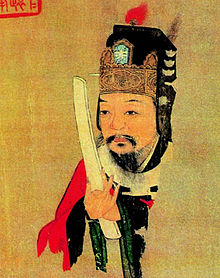Fan Zhongyan
Fan Zhongyan (5 September 989 – 19 June 1052), courtesy name Xiwen (希文), was an accomplished statesman, writer, scholar, and reformer of the northern Song dynasty.
[1] After serving multiple regional posts and at the imperial court for over two decades, Fan was appointed as a vice chancellor by Emperor Renzong to lead the Qingli reforms.
[5] In his late teens and early twenties, Fan Zhongyan travelled and learned with knowledgeable Confucian intellectuals, as well Taoist and Buddhist sages .
He traveled far to today's Shaanxi province and befriended Taoist priests Zhou Debao, Qu Yingyuan, and other intellectuals such as Wang Zhu.
[8] In the early 1020s, Fan served a variety of regional posts, including as magistrate for the Jiqing Army (in modern-day Bozhou, Anhui), and as a salt regulator (盐仓监) in Taizhou.
He advocated for shifting the focus of education from ornamental literary composition to the teachings of ancient sages, emphasizing both moral cultivation and the development of administrative skills in statecraft.
In the capital, Fan openly and strongly condemned the grand councilor Lü Yijian for his favoritism in official selection and promotion.
[15][1] In 1040, faced with the revolt of Tanguts leader Li Yuanhao, the court dispatched Fan along with Han Qi to Shaanxi to inspect the defenses.
Fan re-organized the troops for a more prompt response to Tanguts attacks, and implemented his long-term pursuit of deep defense based on fortified settlements.
During his tenure in Dengzhou, Fan was highly prolific in his literary endeavors, producing numerous essays, poems, epitaphs, and letters, including the mostly quoted "On Yueyang Tower".
In the fall of 1043, Fan Zhongyan and Fu Bi jointly presented a ten-point proposal covering various aspects of government administration, including reforms to the civil examination and recruitment system, higher pay for minor local officials to discourage corruption, and wider sponsorship programs to ensure that officials were drafted more on the basis of merit.
In the early Northern Song era, prefectural schools were neglected by the state and were left to the devices of wealthy patrons who provided private finances.
[26] While Chancellor, Fan Zhongyan issued an edict that provided government funding and private financing to restore and rebuild all prefectural schools that had fallen into disuse and abandoned since the Five Dynasties and Ten Kingdoms (907-960).
[28] Fan's trend of government funding for education set in motion the movement of public schools that eclipsed private academies, which would not be officially reversed until Emperor Lizong of Song in the mid 13th century.
Fan spearheaded a series of initiatives that led to the Qingli Reforms, which aimed to address key issues such as talent recruitment, border defense, and various social and economic challenges faced by the empire.
Additionally, he strengthened Chinese familism by founding the Fan charitable estate, a clan organization that provided education and social support at the community level.
[30][31] Fan Zhongyan was a proponent of ancient Confucian writings and values advocated by his younger associate Ouyang Xiu.
The descriptive prose piece was composed at the invitation of Teng Zongliang, who was then the local prefect and had rebuilt the famed ancient tower.
[9] It contains a most frequently quoted line on the ideal of Chinese scholar-officials: "When they occupied a high position at court, they felt concern for the people.
This quote comes from "Ling Wu Fu" (靈烏賦, a poem on the spirit crow) in 1036, which was written in reply to the advice of a friend, Mei Yaochen.
[37][38][39] To the Tune "Screened by Su curtain" - Nostalgia: [40] [failed verification] 碧雲天,黃葉地,秋色連波,波上寒煙翠。 山映斜陽天接水,芳草無情,更在斜陽外。 黯鄉魂,追旅思,夜夜除非,好夢留人睡。 明月樓高休獨倚,酒入愁腸,化作相思淚。 Clouds veil emerald sky, leaves strewn in yellow dye, waves rise in autumn hue, and blend with mist cold and green in view.


